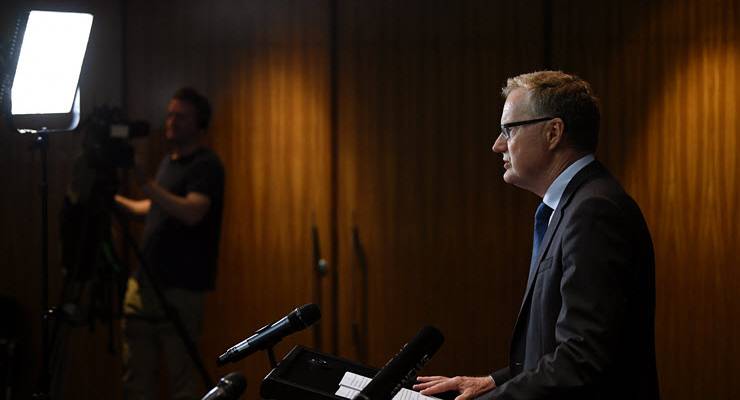
As COVID-19 continues to wreak havoc across the western world, the toll it has also exacted on neoliberal policymaking is growing by the day.
With fiscal policy now devoted to a colossal expansion in the size of government and a trillion dollar debt by the political party that once whined about deficits a fraction the size, the obsession with fiscal discipline and smaller government that is a core part of neoliberal orthodoxy has been put to flight in Australia. Only the vaguest of promises that normal fiscal service will be resumed when unemployment falls below 6% remain.
This week it was the turn of monetary policy, with Reserve Bank (RBA) governor Philip Lowe announcing a significant shift in the bank’s inflation targeting to abandon inflationary forecasts and expectations and instead base policy on actual inflation outcomes.
It also toughened its language on employment, declaring jobs an “important national priority”, and flagging that it doesn’t believe it will be able to reach its inflation target — 2-3% — without “a return to a tight labour market”.
This is significant in two ways.
It recognises that the RBA got it wrong for years on inflation.
From 2016 to now, inflation has only broken an annual rate of 2% in three quarters. Two of them were annual outcomes of 2.1%. But throughout that time the RBA consistently forecast inflation to rise by more than 2%, and based its policy stance on that expected outcome. It left rates at 1.5% that whole time while we struggled, and failed, to get unemployment down below 5%.
The second way is more historic.
Inflation is the holy grail of central banking under contemporary neoliberal policymaking: independent central banks must be allowed a free monetary hand to make sure inflation is kept tightly in check, even at the cost of jobs.
This obsession with inflation was always advertised by neoliberals as crucial to ensuring stability and growth, but it also conveniently served to protect the interests of business by keeping unemployment higher than it otherwise would be.
In time, however, it morphed into something more: loose monetary policy came to be regarded as lax and immoral, policy that pandered to the popular interest in high employment, rather than the important goal of halting inflation.
The RBA’s new stance shifts weight from inflation to unemployment. Inflation is no longer such a potent threat that the mere expectation that it will increase is a trigger for a rate hike. Inflation will have to rise, and stay higher, to trigger a change in rates. And the bank wants a tight labour market to bring it about, not just falling unemployment.
The RBA isn’t the only central bank shifting. In August, the US Federal Reserve abandoned its strict inflation target in favour of a more flexible 2% target, similar to that of the RBA.
It’s now forgotten that while the RBA sat tight from 2016 to 2019, it was criticised for not increasing rates by The Australian Financial Review and favoured AFR commentators like Warwick McKibbin and Warren Hogan.
At one stage, Hogan called for rate rises even at the cost of employment. It wasn’t good enough for neoliberals that the RBA wasn’t cutting rates because its erroneous inflation forecasts suggested a return to inflation within the target band — it should be increasing rates even if inflation was going to return to the target band. If necessary, the inflation band should be changed to 1% in order to push interest rates up.
That’s how obsessed neoliberals have been with inflation targeting. Inflation became an end in itself, the be-all and end-all of monetary policy regardless of the impacts on the lives of real people.
The new RBA stance will likely see a lot of economists, especially those high profile ones in the markets, without very much to do, especially for the next three years given the RBA has persistently ruled out rate rises in that time.
Instead of grabbing easy headlines with predictions of interest rate moves, economists will have to lift their game trying to explain what is actually happening in the wider economy.
Some are better placed for this than others: the National Australian Bank does a very good job with its monthly business conditions and confidence survey and accompanying analysis. AMP’s Shane Oliver and his small team turn out good analysis of statistics and their potential explanation of what is happening in the economy and their impact on the sharemarket in particular.
One indicator that may receive more attention now is the Beveridge, or UV, curve, which plots the relationship between unemployment and the job vacancy rate — in short, how many unemployed people there are available for each vacant job.
It is already in extensive use in central bank studies of labour force equilibrium, using ideas like frictional unemployment, skills mismatches and movements in the participation rate. It may well probably replace the enigmatic NAIRU (non-accelerating inflation rate of unemployment), which powerfully symbolises the subordination of employment to inflation, as the market’s fixation in coming years
The curve is named after William Beveridge, the UK progressive economist responsible for the World War II paper that laid the foundations for the British welfare state. Neoliberals will be mortified. But 2020 has been the year from hell for them too.









Crikey is committed to hosting lively discussions. Help us keep the conversation useful, interesting and welcoming. We aim to publish comments quickly in the interest of promoting robust conversation, but we’re a small team and we deploy filters to protect against legal risk. Occasionally your comment may be held up while we review, but we’re working as fast as we can to keep the conversation rolling.
The Crikey comment section is members-only content. Please subscribe to leave a comment.
The Crikey comment section is members-only content. Please login to leave a comment.